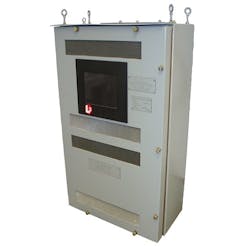Bath Iron Works and L-3 to provide power-control systems for Burke-class destroyer shipboard power
Officials of the Navy's Supervisor of Shipbuilding, Conversion, and Repair in Bath, Maine, announced a $9.6 million order Tuesday to General Dynamics Bath Iron Works in Bath, Maine, to add new integrated power node centers on three Burke-class destroyers that are under construction at Bath Iron Works.
Bath Iron Works will provide material and labor to add new integrated power node centers on the USS John Basilone (DDG 122); USS Harvey C. Barnum Jr. (DDG 124); and USS Gallagher (DDG 127).
The company will replace the ships’ current centralized 400-Hz power-distribution system, which consists of two air-cooled solid state frequency converters. The new integrated power node center combines power transfer, frequency conversion, voltage transformation, power conditioning, and fault protection into one cabinet.
Bath Iron Works is acquiring the integrated power node centers from L-3 SPD Electrical Systems in Philadelphia. L-3 is providing the company's Power Node Control Center (PNCC) for the job. Eight PNCC units will be installed on each Burke-class destroyer, beginning with the Basilone, and the USS Frank E. Petersen Jr. (DDG-121).
Related: Demand for shipboard power generation and control has no end in sight
Primarily developed through internal research and development, L-3’s PNCC is an integrated electrical system that can be configured to perform several functions simultaneously, including operating as a transfer switch, frequency converter, circuit breaker, power conditioner, power transformer, and motor controller, L-3 officials say.
The PNCC is designed to convert power for a variety of applications, ranging from commercial-off-the-shelf (COTS) to qualified MIL-SPEC equipment, allowing for reduced weight and space requirements.
On this order Bath Iron Works will do the work in Bath, Maine, and should be finished by November 2022. For more information contact General Dynamics Bath Iron Works online at www.gdbiw.com, L-3 SPD Electrical Systems at www.l-3mps.com/spdes, or the Navy Supervisor of Shipbuilding, Conversion, and Repair at www.navsea.navy.mil/Home/SUPSHIP.
Ready to make a purchase? Search the Military & Aerospace Electronics Buyer's Guide for companies, new products, press releases, and videos
